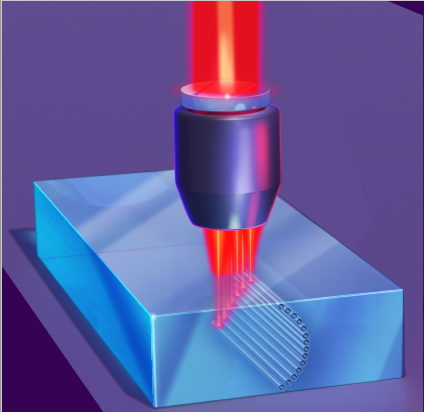Background: Laser glass cutting
Laser glass cutting is usually done using ultra-fast lasers in the IR, typically around 1um wavelength. The laser energy is focused into the glass, inducing non-linear absorption and plasma filament creation, cracking the glass in a controlled manner. This focused spot is then scanned to create the cut contour. The main laser shaping challenge in laser glass cutting is due to the requirements of the non-linear process. The non-linear effects require high power densities, thus tight focusing to 1-5um spots typically, but such spot have very limited depth of focus, of less than 0.1mm. For thicker glass cutting, laser shaping methods must be used to generate a profile that has a tight spot but with a depth of focus equal to the glass thickness, i.e. 1mm or more, in most cases.
Laser shaping for glass cutting
There are various laser shaping approaches to address the challenge of tight focusing over a long depth of focus:
- Bessel like beams, often generated by Diffractive Axicons, can create a continuous elongated focus region with a tight focus, enabling filamentation laser glass cutting. This type of beam is highly useful for straight that are perpendicular to a flat glass surface, but cannot be easily used at an angle as the Bessel beam becomes distorted.
- Modified Bessel like beams, with uniform intensity in the focal range, such as those generated by Holo/Or’s DeepCleave module , can cut glass more efficiently as the energy is better defined in the bulk. However, they still have the same limits as axicon generated Bessel beams, and cannot cut at angle without degradation in performance.
- Multifocal DOEs can split the focus of an external objective to a line of foci with controlled separations. Such a line can cover a range much larger than the Rayleigh range, and with correct laser shaping the spot distances can be tailored to give a smooth fracturing of the glass.
All these methods are more suitable for main glass cuts that define the part, but less suitable for cutting of bevels on the part edge. This requires another secondary process of mechanical grinding to achieve beveled edges, that are critical for both safe handling of glass and glass durability.
There is a method of laser shaping that enables the real time cutting of both glass and bevel. This is a method we call “3D beam shaping” at Holo/Or.
What is 3D laser beam shaping
3D beam shaping is a laser shaping method where the focus is split into multiple foci in both the x-y plane as well as in the focal direction, combining the action of a Multifocal DOE with a diffractive beam splitter. The result is a collection of foci that does have to be in a straight line. The foci can be tailored to create a Trapeze or C shape pattern, enabling both main cut, top and bottom bevels to be done simultaniosluy in one laser pass.

TL;DR - Q&A summary
Q: What is laser glass cutting?
A: Laser glass cutting is the process of cutting glass by laser radiation, rather than mechanical or chemical methods. Most laser glass cutting today is done by the filamentation method , using ultra short IR lasers focused to a tight spot.
Q: Why is laser shaping needed for laser glass cutting?
A: To achieve high quality cutting, the laser needs to be focused to a tight spot , which has a small depth of focus. Laser beam shaping is needed to extend the depth of focus so that it covers the entire glass thickness.
Q: What is 3D beam shaping?
A: 3D beam shaping is a method where a single DOE splits the laser foci in both the X-Y plane as well as along the optical axis (z). This means that the cut path in glass can be not just a straight line.
Q: What is the utility of 3D beam shaping for laser glass cutting ?
A:. By Shaping the laser foci in a C or a Trapeze pattern, the laser can now be used to cut the glass while simultaneously creating a bottom and top bevel. This saves time and reduced processing steps.

